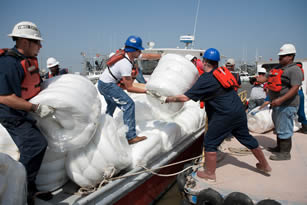A new era dawned for the oil industry on 20 April 2010. Since the oil platform “Deepwater Horizon” went up in flames that day, the industry has been experiencing significant changes.
p>A new era dawned for the oil industry on 20 April 2010. Since the oil platform “Deepwater Horizon” went up in flames that day, the industry has been experiencing significant changes.
 Valve makers are just as much affected as the offshore supplier sector - for it was the blowout preventer (BOP) that malfunctioned during the fatal blowout on the “Deepwater Horizon”, the only protection valve securing against an uncontrolled outflow on an oil platform. BOP-makers however do not have to shuffle along the streets with their shoulders burdened from feeling guilty; those makers which can namely offer high-quality BOPs will have great opportunities to sell their products to the oil industry. The catastrophe put an end to an era which prioritised the price of a BOP.
Valve makers are just as much affected as the offshore supplier sector - for it was the blowout preventer (BOP) that malfunctioned during the fatal blowout on the “Deepwater Horizon”, the only protection valve securing against an uncontrolled outflow on an oil platform. BOP-makers however do not have to shuffle along the streets with their shoulders burdened from feeling guilty; those makers which can namely offer high-quality BOPs will have great opportunities to sell their products to the oil industry. The catastrophe put an end to an era which prioritised the price of a BOP.
Quality, not insecurity
In the future, the reliability of protection valves in extraction and drilling will be the main factor, not only in the oil business. The outcome of the tragedy on US shores has made the necessity of such valves painfully obvious. According to experts, a total of 780mn litres of crude oil leaked into the Gulf of Mexico in the three months until the well was sealed. This had fatal effects on the environment – thousands of animals perished. Nine days after the explosion, the slick was washed onto the shores of Louisiana. Fishing in the region was temporarily forbidden by the US government. The tourism industry has suffered financially. President Barack Obama stated “this oil spill is the worst environmental disaster America has ever faced.”
“A horrible tragedy”
Meanwhile, the ocean has started recovering – natures ability to heal is making itself shown and it will probably be the greatest aid in containing the spill. Experts believe nearly half of the crude oil which was spilled has evaporated, or has dissolved into microscopic droplets which are broken down by saltwater bacteria “Merely” a quarter of the oil is still swimming on the surface of the ocean, or is on the coast and beach as lumps of sludge and tar. Yet the combination of nature’s abilities and humanity‘s efforts in the fight against the spill will not save the oil industry from changes which will effect numerous sectors.
The disaster also had a short-term effect for Tony Hayward, who had to step down from playing crisis manager and resign from his position as CEO of the company. Hayward sees extensive damage for the sector’s public image. New offshore drilling and exploration projects can only commence when trust has been won back again. Valve makers will also profit from the oil industry’s return to business.
Growing security requirements
BP has to set itself up financially to meet the costs of oil spill, which can be as high as $32bn. As a consequence, BP witnessed a huge loss of $17bn in its second quarter, as the oil corporation had to put $20bn aside for a compensation fund and a further three billion dollars were used to pay for costs incurred. In the end, the disaster could grow to be a crisis for the entire sector, as the requirements and barriers for exploration will be set higher than before. It is likely that the state will intervene and safety requirements for all deep sea exploration will be made far stricter in general. “I would like to be certain that EU's standards are set at the highest possible level in order to maintain the most stringent regime in the world”, stated EU energy commissioner Günther Oettinger recently. He demanded a moratorium for deep sea exploration and extraction in Europe until the European Commission had finalised its study concerning the security of oil exploration. On the other hand, the US government has announced far more extensive and protracted approval procedures for the future. Higher security requirements and rising insurance costs increase the costs of oil production. Tom Moskitis of the American Gas Association stated it would become more difficult to produce oil in new regions. These developments will have an impact on the valve and fittings industry.
Protests against deepwater drilling
An opposition against deepwater drilling has already organised itself. Activists of environmental protection group Greenpeace stopped test drills in the arctic, off of the coast of Greenland, undertaken by an oil platform belonging to Scottish company Cairn. Greenpeace speaker Jurrien Westerhof declared there was no experience to draw from in regards to drilling platforms in the Arctic Circle. “The catastrophe in the Gulf has shown us problems we never would have imagined”, said Eyvind Vesselbo, Spokesman on the Environment of the ruling Danish right-wing/liberal party Venstre. An oil spill off the coast of Greenland would be even more catastrophic due to the extreme climatic conditions. There would be no way to stop oil from spilling into the ocean if an accident were to occur at the well, due to the thick arctic ice separating an oil platform from the well.
Test drills in Norway are also becoming less likely in the aftermath of the BP catastrophe. Norway‘s minister for oil and energy Terje Riis-Johansen believes it would be a mistake to carry out planned test drills near the Lofoten islands in the north of Norway. One merely has to keep the disaster in the Gulf of Mexico in mind. “It would be fatal to ignore it.”
An incentive for the valve and fittings industry
A certain amount of scepticism has been making its rounds in the supplier sectors since the disaster, including the valve industry. “Many projects are being delayed”, says Hauke Schlegel, head of the German engineering federation VDMA working group shipbuilding and offshore suppliers. Schlegel however doesn’t want to paint a bleak picture. The events “won’t test the oil sectors limits”. He doesn’t believe the disaster will have a Chernobyl effect on the oil industry. However, technical advancements have to be made. “We need even more high tech for such plants.” This could be an incentive, “naturally also for the valve industry.”
This is especially the case for safeguards against blowouts, which will be a greater challenge than ever before for valve makers. The so-called BOP was supposed to keep the Deepwater Horizon safe from a blowout – yet it neither automatically secured the well during the blowout, nor could it be activated later on. A critical failure, as the BOP is the only safeguard against an oil spill, making it the single most essential piece of equipment should disaster strike. In this case, the blowout preventer on the ill-fated oil platform in the Gulf of Mexico became an ineffective hulk with a weight of 300 t and a height of 15 m.
Equipped with the newest BOP
The BOP placed right above Deepwater Horizon’s well was supposed to shut off the 48cm thick feed pipe with its hydraulic rams in three stages. According to makers, the newest generation of BOP’s are supposed to withstand 3500 atmosphere of pressure in depths of up to 4600 m and temperatures of 260°C. Whatever the case may be, the Deepwater Horizon was supposed to have been equipped with the newest blowout preventer.
Should a blowout occur, two ram preventers encircling the drill pipe are activated, making sure the pipe is sealed. Another fail-safe, the annular, is supposed to do the same. This valve pushes a rubber ring surrounding the pipe vertically together, sealing the openhole. Should this fail, then the shear rams are supposed to cut through the drill string, crimping the well and sealing it off.
Finding the cause of failure
Alas, none of Deepwater Horizon’s blowout prevents functioned. BP’s former CEO Tony Hayward declared his company must “use this incident as a case study to avoid a similar failure in the future”. The future of deepwater oil exploration and production will depend on this. Particularly since voices are being heard claiming that the BOP in the Gulf of Mexico wasn’t the only one to fail in recent years. According to Senator Maria Cantwell there were 117 known cases of malfunctioning blowout preventers in the late 1990's. A report of the US Minerals Management service documented reoccurring defects.
The valve industry has to react and work on improving the blowout preventers it manufactures, for it will be detrimental to business if the amount of deep-sea drillings crumbles due to uncertainties in regards to an eventual blowout. It would, however, be the other way around if blowout preventers were to operate flawlessly, as this would create the safety needed for a potential future deep-sea exploration and production market. Whatever the case may be, the challenge to build BOPs that can withstand adverse conditions deep under the sea is huge.
Vacuum cleaners for the shores
Valves not only play a major role in preventing a blowout, but are also a central piece of hardware elsewhere – in industry-grade vacuumers for example, which suck the oil slick from the ocean surface. “This could create a market”, assumes Hauke Schlegel of the VDMA’s working group for shipbuilding and offshore suppliers. It could happen that future laws will require such equipment to be held available, for instance near the coast.
A Hollywood start caught the oil industry’s attention, after he turned into a real-life hero. After highly successful test runs, BP ordered 32 centrifugal oil-water separators from Kevin Costner’s company Ocean Therapy Solutions, which are able to clean 800,000 l of water a day. The centrifuges suck in sea water and oil and separate them from each other. Over 99 per cent of the oil is separated from the sea water, which flows back into the ocean. The oil itself is stored and can be used.
Yet what role will oil have as a source of energy? The hunger and demand for oil is as high as ever. Emerging markets such as China and India are cranking up demand, whilst Western Europe needs increasingly more energy. Experts foresee demand increasing from the current 107,000 TWh to 160,500 TWh per year. By 2060, demand will double to approximately 320,000.
Oil, however, is in decline. Other forms of energy, such as natural gas and renewable energy, are becoming increasingly important. Germany’s Federal Institute for Geosciences and Natural Resources claims half of the world’s exploitable oil will have been all but used up in the next ten to 15 years. “We already are in the middle of the Peak Oil phase”, claims Hans-Jochen Luhmann of the German Wuppertal Institute for Climate, Environment and Energy. Other experts believe the Rubicon will be crossed in 2020.
Oil addiction nursed in the deep sea
The search for oil is becoming increasingly difficult as the supply of black gold dwindles. Experts claim around one quarter of known reserves is supposed to lay waiting under the sea bed. Most of the treasure is believed to be found in the southern Atlantic, between Brazil, Angola and the Gulf of Mexico. “Our addiction to oil is leading us towards the deep sea”, declares Catalin Teodoriu of the Institute of Petroleum Engineering located at the Clausthal University of Technology, Germany. “We can only discover new fields where no one has ever looked before, deeper down in the ocean, in the Arctic and Antarctic.” As a consequence, deep-sea drills, like the one in the Gulf of Mexico, will increase in number, despite being complicated and expensive. Yet the rising price of oil makes the entire technical effort worthwhile. The black gold fever will however cool down if the technology for deep-sea exploration and extraction is not developed further. The oil industry cannot allow another disaster like the one in the Gulf of Mexico to happen.




